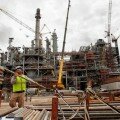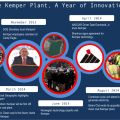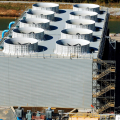Since operations began at Mississippi Power’s Kemper Plant on August 9, 2014, it is estimated that the reliability of Kemper’s combined cycle has saved customers approximately $15 million dollars due to the unit’s modern efficiency and low maintenance costs.
“I’ve been in the power industry for more than 30 years. I’ve worked around all sorts of power plants, but what Kemper has achieved is a world class level of reliability, especially for a new installation,” said Jeff Parsley, plant manager. “That outstanding rate means this plant is now typically available 99 percent of the time to provide our customers with reliable, affordable electricity.”
Kemper’s power output has replaced that which had previously been derived from much older, less efficient facilities in the Mississippi Power fleet.
“After Hurricane Katrina, our company, and subsequently the Public Service Commission, saw a need for a newer base-load facility to continue the excellent reliability scores that our customers expect and for which our company is known throughout the industry,” said Allen Reaves, vice president of Generation and senior production officer. “Since it began serving customers last year, Kemper has more than demonstrated its ability to fulfill that goal.”
The combined cycle plant at the Mississippi Power Kemper Coal Plant combines two combustion turbines, which currently runs on natural gas, with one steam turbine. When the Kemper County energy facility’s two lignite gasifiers begin operation, the combustion turbines will begin running on syngas derived from gasified lignite. Kemper is already making some of its own fuel, thanks to the heat recovery steam generators now in operation. When Kemper begins gasification of lignite, it will not only use the syngas from the lignite to power the combustion turbines, it will also use heat generated from the gasification process to make even more steam available for the steam turbine.
“Modern combined cycles just have a lot of flexibility, reliability and self-sustaining technology built into them,” Parsley concluded. “And this one has proven itself time and time again in its first year.”





 #Kemper is capable of producing much cleaner energy from coal, that’s why energy leaders are watching so closely.
#Kemper is capable of producing much cleaner energy from coal, that’s why energy leaders are watching so closely.